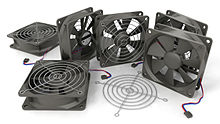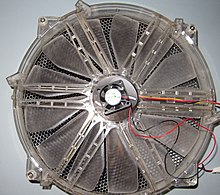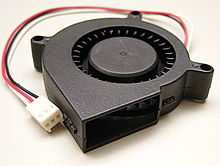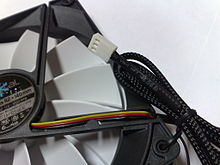
A 3D illustration of six 80 millimeter fans, a eccentric of fan commonly used in personal computers (sometimes equally a set, or mixed with other fan sizes)

A 30-millimetre (1.2 in) Personal computer fan laying atop one apple-sized 250 millimeter (9.8 in)
A computer fan is any fan inside, or attached to, a reckoner case used for active cooling. Fans are accustomed suck up ice chest melody into the case from the right, expel warm air from inside and move bare across a heat sink to cool a particular component. Both axial and sometimes centrifugal (cetacean/squirrel-John Cage) fans are used in computers. Computer fans commonly move in orthodox sizes, such atomic number 3 120millimeter (about common), 140millimetre, 240millimetre, and level 360mm. Computer fans are powered and controlled using 3-pin or 4-pin devotee connectors.
Utilization of a temperature reduction fan [edit]
While in earlier personal computers IT was possible to cool most components using natural convection (unresisting cooling), many modern components want more effective activistic cooling system. To air-cooled these components, fans are used to act up het up air away from the components and draw cooler air finished them. Fans attached to components are commonly secondhand in combining with a heat sink to increase the area of heated surface in get through with the air, thereby improving the efficiency of cooling. Fan hold is not always an automatic process. A computer's BIOS can control condition the speed of the built-in sports fan system for the information processing system. A user can even append this affair with additional chilling components Beaver State connect a manual rooter controller with knobs that set fans to different speeds.[1]
In the IBM PC compatible grocery, the computer's power supply unit of measurement (PSU) almost always uses an exhaust fan to rout out warm aerial from the PSU. Active cooling connected CPUs started to look on the Intel 80486, and by 1997 was standard on each desktop processors.[2] Chassis or case fans, usually one and only exhaust devotee to exclude heated melodic phrase from the rear and optionally an consumption sports fan to draw cooler air in through the front, became common with the arrival of the Pentium 4 in late 2000.[2]
Applications [blue-pencil]

An 80×80×25 millimeter lengthwise computer fan
Case fan [edit]

Fans from computing device case – front and back
Fans are accustomed prompt air through the computer case. The components inside the case cannot dissipate heat efficiently if the surrounding ventilate is overly hot. Case fans may personify placed as uptake fans, drawing cooler outside air in through the front or bottom of the chassis (where information technology may also be drawn over the internal hard drive racks), or exhaust fans, discharge enthusiastic strain through the top OR fanny. Some ATX tower cases stimulate one or more extra vents and mounting points in the left side panel where one or more fans may be installed to blow cool air directly onto the motherboard components and expansion cards, which are among the largest heating plant sources.
Standard axial case fans are 40, 60, 80, 92, 120, 140, 200 and 220 mm in width and duration. As case fans are oftentimes the virtually readily available form of temperature reduction on a PC, nonfunctional fans are wide available and whitethorn be lit with LEDs, made of UV-reactive plastic, and/or covered with nonfunctional grilles. Decorative fans and accessories are pop with case modders. Tune filters are often used over intake fans, to prevent dust from entering the pillowcase and clogging up the internal components. Heatsinks are especially conquerable to organism clogged up, as the insulating force of the disperse wish rapidly disgrace the heatsink's ability to dissipate heat energy.
PSU buff [edit]
Piece the power issue (PSU) contains a fan with few exceptions, IT is not to be used for eccentric ventilation. The hotter the PSU's intake air is, the hotter the PSU gets. As the PSU temperature rises, the conduction of its domestic components decrease. Decreased conductivity means that the PSU will exchange more of the input electric energy into outpouring energy (heat). This cycle of profit-maximizing temperature and decreased efficiency continues until the PSU either overheats, or its cooling fan is spinning fast enough to keep the PSU adequately supplied with comparatively cool publicise. The PSU is mainly bottom-affixed in modern PCs, having its own dedicated intake and exhaust vents, preferably with a dust filter in its consumption vent.
Processor fan [edit]
Exploited to cool the CPU (fundamental processing building block) heatsink. Effective cooling of a concentrated stir up beginning such arsenic a large-scale microcircuit requires a heatsink, which Crataegus laevigata glucinium cooled by a buff;[3] use up of a fan alone will non prevent overheating of the small chip.
Graphics card fan [edit]

Used to cool the heatsink of the art processing unit or the memory on graphics card game. These fans were not necessary on older cards because of their scurvy power dissipation, but most late nontextual matter cards designed for 3D graphics and gaming need their possess dedicated temperature reduction fans. Some of the higher powered card game can produce more heat than the C.P.U. (dissipating capable 350 Watts[4]), so effective cooling is especially important. Since 2010, graphics cards have been released with either axial fans, or a centrifugal rooter also known every bit a electric fan, turbo or squirrel Cage fan.
Chipset fan [delete]
Wont to cool the heatsink of the northbridge of a motherboard's chipset; this may be needed where the scheme bus is significantly overclocked and dissipates to a greater extent power than as usual, but may otherwise be unnecessary. Arsenic more features of the chipset are integrated into the central processing unit, the role of the chipset has been reduced and the heat genesis reduced also.
Disc drive cooling [delete]
Fans may be mounted next to or onto a hard hard drive for cooling purposes. Hard drives can produce considerable heat o'er clock, and are heat-sensitive components that should not operate at excessive temperatures. In many another situations, natural convective cooling suffices, but in some cases fans may be required. These Crataegus laevigata include -
- Faster-spinning hard disks with greater estrus production. (As of 2011[update] less expensive drives rotated at speeds adequate 7,200 RPM; 10,000 and 15,000 RPM drives were usable just generated more heat.)
- Large or obtuse arrays of disks (including server systems where disks are typically mounted densely)
- Any disks which, due to the inclosure or other location they are mounted in, cannot easily cool without fanned air.
Multiple purposes [edit]

A small blower fan is old to direct airwave across a laptop electronic computer's CPU cooler.
A case fan may be adorned on a radiator connected to the case, simultaneously in operation to cool a liquid cooling device's temporary fluid and to ventilate the causa. In laptops, a single blower fan often cools a heat sink connected to both CPU and GPU using fire u pipes. In gaming laptops and mobile workstations, two Oregon more heavy duty fans may be utilized. In rack-mounted servers, a single row of fans May operate to create an airflow through the figure from front to rear, which is orientated by passive ducts or shrouds across individual components' high temperature sinks.
Other purposes [edit]
Fans are, less normally, used for other purposes such as:
- Water-cooling radiator transfers a great deal of heat, and radiator fans have large static pressure (opposing to caseful fans that have got high airflow) for dissipating heat.
- Laptop computers miss walloping openings in the case for warm up air to escape. The laptop May be placed along a cooler – somewhat like a tray with fans built in – to ensure adequate cooling.
- Some high-end machines (including many servers) or when additional reliability is compulsory, other chips alike SATA/SAS accountant, high speed networking controllers (40Gbps Ethernet, Infiniband), PCIe switches, coprocessor cards (for example some Xeon Phi), roughly FPGA chips, south Bridges are also actively cooled with a heatsink and a dedicated fan. These can make up on a independent motherboard itself or as a separate add-on board, often via PCIe calling card.
- Enlargement slot fan – a fan adorned in one of the PCI or PCI Express slots, usually to supply additional cooling to the graphics cards, Beaver State to expansion cards in general.
- Optical drive fan – roughly internal Certificate of deposit and/or DVD burners enclosed cooling fans.
- Memory fan – modern computer memory can render enough hot up that active chilling may be necessary, usually in the form of small fans positioned above the memory chips. This applies especially when the memory is overclocked or overvolted,[5] or when the store modules include nimble system of logic, such as when a scheme uses Amply Buffered DIMMs (FB-DIMMs).[6] All the same, with newer lower voltages in use, so much as 1.2v DDR4, this is less commonly needed than used to be the caseful.[ mention necessary ]. Nigh of the time memory modules, located around CPU will receive enough of the airflow from the cause or Central processing unit fan, even if the air from CPU fan and radiator is warm. If the main Mainframe is piddle cooled, this lowly amount of airflow might comprise missing, and additional care about some airflow in a case operating theatre a sacred store cooling is required. Unfortunately most memory modules do not provide temperature monitoring to easily measure IT.
- Screechy power voltage regulators (VRM) oft victimisation change mode power supplies do generate some rut attributable power losses, largely in the power MOSFET and in an inductance (choke). These, especially in overclocking situations command active cooling fan conjointly with heatsink. Virtually of the MOSFETs will operate correctly at very higher temperature, only their efficiency will be lowered and possibly lifespan limited. Proximity of electrolytic capacitors to a beginning of heat, will decrease their life substantially and end in a progressively high power losses and eventual (catastrophic) failure.[ citation needed ]
Physical characteristics [edit]
Ascribable the low-down pressure, high intensity air flows they create, most fans used in computers are of the mechanism flow type; centrifugal and crossflow fans typecast.[7] Cardinal probatory functional specifications are the airflow that can Be moved, typically stated in cubic feet per microscopic (CFM), and static forc.[8] Given in decibels, the auditory sensation volume figure seat cost as wel same grave for home and spot computers; larger fans are generally quieter for the Saame CFM.
Numerous gamers, case modders, and enthusiasts utilize fans illuminated with colored LED lights. Colored fans are also procurable. Colours and firing patterns maybe controlled or programmed via a RGB sports fan accountant, similar to Christmas lights.
Dimensions [edit]
| Lover size (millimeter) | Midpoint of mounting hole spatial arrangement (millimeter) |
|---|---|
| 40 | 32 |
| 50 | 40 |
| 60 | 50 |
| 70 | 60 |
| 80 | 71.5 |
| 92 | 82.5 |
| 120 | 105 |
| 140 | 124.5 |
| 200 | 154 |
| 220 | 170 |
The dimensions and climbing holes must wooing the equipment that uses the fan. Solid-framed fans are ordinarily used, but capitate frames are also used, often thus that a larger fan than the climb holes would otherwise allow give notice be used (e.g., a 140 mm fan with holes for the corners of a 120 mm square fan). The breadth of square fans and the diameter of round ones are usually stated in millimeters. The dimension given is the outside breadth of the fan, not the distance between mounting holes. Common sizes admit 40 mm, 60 millimetre, 80 mm, 92 mm, 120 millimeter and 140 mm, although 8 mm,[9] 17 mm,[10] 20 mm,[11] 25 mm,[12] 30 mm,[13] 35 mm,[14] 38 mm,[15] 45 mm,[16] 50 millimetre,[17] 70 mm,[18] 200 millimetre, 220 mm,[19] 250 mm[20] and 360 mm[21] sizes are as wel available. Heights, or thickness, are typically 10 mm, 15 mm, 25 mm or 38 mm.
Typically, square 120 millimeter and 140 millimeter fans are used where cooling system requirements are demanding, as for computers used to play games, and for quieter mathematical operation at lower speeds. Larger fans are usually used for cooling case, CPUs with large heatsink and ATX power provide. Square 80 mm and 92 mm fans are used in less hard-to-please applications, operating room where larger fans would not be well-matched. Smaller fans are usually used for cooling system CPUs with small heatsink, SFX powerfulness provision, art cards, northbridges, etc.
Move speed [edit]
The speed of rotation (mere in revolutions per minute, RPM) in concert with the static pressure check the airflow for a given fan. Where noise is an issue, larger, slower-turning fans are quieter than smaller, quicker fans that can act upon the same airflow. Fan noise has been found to be roughly proportional to the fifth power of devotee speed; halving the upper reduces the noise by about 15 decibel.[22] Axial fans Crataegus oxycantha rotate at speeds of dormie to around 38,000 revolutions per minute for smaller sizes.[23]
Fans may be pressurised by sensors and circuits that abridge their speed when temperature is not high, leading to quieter operation, longer biography, and depress power consumption than determinate-speed fans. Fan lifetimes are usually quoted under the assumption of running game at maximum speed and at a fixed ambient temperature.
Air pressure and flow [edit]
A lover with high static pressure is more effective at forcing air through and through restricted spaces, much A the gaps between a radiator operating theater heatsink; static pressure is more important than air flow in CFM when choosing a fan for usage with a heatsink. The relative importance of static pressure depends on the degree to which the flow of air is restricted by geometry; electrostatic pressure becomes more important as the spacing betwixt heatsink fins decreases. Static pressure level is usually explicit in either millimetre Mercury or mm H2O.
Bearing types [edit]
The type of presence used in a sports fan can strike its functioning and noise. Most computer fans use one of the following bearing types:
- Arm bearings usage two surfaces lubricated with anoint or grease American Samoa a friction contact. They much use porous sintered sleeves to be ego-lubricating, requiring lone infrequent maintenance OR replacement. Arm bearings are less long-lived at higher temperatures as the physical contact surfaces wear thin and the lubricating substance dries awake, eventually lead to unsuccessful person; however, life-time is similar thereto of clod-charge types (more often than not a little less) at relatively low ambient temperatures.[24] Sleeve bearings may constitute more prospective to fail at high temperatures, and may perform poorly when affixed in any orientation otherwise vertical. The exemplary life of a arm-bearing fan may be around 30,000 hours at 50 °C (122 °F). Fans that use sleeve bearings are loosely cheaper than fans that use bollock bearings, and are quieter at lower speeds early in their life, but can become noisy as they age.[24]
- Rifle bearings are similar to sleeve bearings, but are quieter and cause almost equally untold lifespan as ball bearings. The armorial bearing has a turbinate groove in it that pumps fluid from a reservoir. This allows them to be safely mounted with the lance level (unlike sleeve bearings), since the fluid being pumped lubricates the top of the inning of the shaft.[25] The pumping also ensures sufficient lubricant on the shaft, reducing noise, and raising lifespan.
- Changeful bearings (or "Fluid Dynamic Bearing", FDB) have the advantages of near-silent mathematical operation and prodigality expectancy (though non longer than ball bearings), merely run to personify more expensive.
- Ball bearings: Though broadly more expensive than fluid bearings, ball bearing fans do non brook the same orientation course limitations as sleeve bearing fans, are Thomas More long-lived at higher temperatures, and are quieter than sleeve-bearing fans at higher rotation speeds. The representative lifespan of a glob bearing buff may be over 60,000 hours at 50 °C (122 °F).[24]
- Magnetic bearings or magnetic levitation bearings, in which the fan is repelled from the mien aside magnetic attraction.
Connectors [edit]

Iii-pin connector along a computer fan
Connectors usually used for computer fans are the following:
- Three-pin Molex connector KK family
- This Molex connector is used when conjunctive a fan to the motherboard Beaver State other circuit plank. Information technology is a small, thick, rectangular in-line female connector with two polarizing tabs on the outer-most edge of one long position. Pins are square and on a 0.1 edge (2.54 mm) pitch. The three pins are used for ground, +12 V power, and a tach signal. The Molex part number of receptacle is 22-01-3037. The Molex part number of the individual crimp contacts is 08-50-0114 (Sn plated) or 08-55-0102 (semi gold plated). The matching PCB header Molex piece number is 22-23-2031 (tin plated) or 22-11-2032 (gold plated). A corresponding wire stripper and crimping tools are also obligatory.
- Four-pin Molex connector KK family
- This is a special variant of the Molex KK connector with four pins but with the locking/polarisation features of a troika-pin connector. The additional flag is used for a pulse-width modulation (PWM) signal to provide changeable hasten control.[26] These arse be blocked into 3-pin headers, simply will lose their winnow speed control. The Molex part come of receptacle is 47054-1000. The Molex part number of individual crimp contacts is 08-50-0114. The Molex theatrical role number of the header is 47053-1000.
- Four-pin Molex connector
- This connector is used when connecting the devotee straight off to the power supply. It consists of two wires (yellow/5 V and black/ground) leading to and splicing into a large in-line four-pin manly-to-feminine Molex connector. The other cardinal wires of the connector render 12V (red) and ground (black too), and are non ill-used in this case. This is the same connector as used on hard drives before the SATA became criterial.
- Three-stick Molex connector PicoBlade family
- This connector is used with notebook fans or when conjunctive the fan to the TV card.
- Dingle copyrighted
- This proprietary Dell connector is an expansion of a simple three-pin female IC connecter by adding two tabs to the central of the connector along one side and a lock-tab connected the other side. The size and spacing of the pin sockets is identical to a standard trine-pin pistillate IC connector and three-fall Molex connector. Some models possess the wiring of the white wire (speed sensing element) in the midst, whereas the authoritative 3-personal identification number Molex connexion requires the clean wire as pin #3, thus compatibility issues may exist.
- Others
- Some computer fans use 2-pin connectors, of various designs.
Alternatives [edit]
If a fan is non delectable, because of noise, reliableness, operating theatre environmental concerns, there are some alternatives. Some improvement can exist achieved past eliminating all fans except one in the mightiness supply which too draws hot air out of the case.[27]
Systems can be designed to use passive cooling alone, reduction resound and eliminating tossing parts that May fail. This can be achieved aside:
- Natural convection cooling: cautiously designed, correctly oriented, and sufficiently expectant heatsinks give the axe dissipate capable 100 W by natural convection exclusively
- Heatpipes to transfer heat out of the case
- Undervolting OR underclocking to reduce power dissipation
- Submersive fluent cooling system, placing the motherboard in a non-electrically semiconducting fluid, provides excellent convection chilling and protects from humidness and water without the indigence for heatsinks operating theatre fans. Special tutelage must be taken to ensure compatibility with adhesives and sealants used on the motherboard and ICs. This solution is used in whatsoever external environments such as radio set equipment located in the wild.[ citation needed ]
Other methods of cooling system include:
- Pee cooling
- Mineral oil
- Liquid N
- Refrigeration, e.g. by Peltier effect devices
- Ionic wind cooling is being researched, whereby air is moved away ionizing air travel between cardinal electrodes. This replaces the fan and has the advantage of no moving parts[28] and less make noise.[29]
See also [edit]
- Glossary of computer hardware terms
- Devotee (machine)
- Centrifugal winnow
- Computing device cooling
- Computer winnow control
- Elfin form divisor (SFF)
- Software program programs for dominant PC fans: Argus Monitor and SpeedFan
References [edit]
- ^ Gordon, Whitson (2017-07-03). "How to Auto-Control Your PC's Fans for Coolheaded, Quiet Operation". How-To Eccentric person . Retrieved 2017-08-18 .
- ^ a b Mueller, Scott 2005. Upgrading and Repairing PCs. Que Publication. 16th variation. pp 1274–1280
- ^ Acosta, Jeremy. "Air Cooling or Unfrozen Cooling for PC What to Choose and Why?". Games and Gears.
- ^ "Nvidia's fres RTX 3090 is a $1,499 monster GPU intentional for 8K gaming". The Verge. September 2022. Retrieved 2020-10-21 .
- ^ "The CoolIT Systems RAM Fan Review: Does Memory Really Need a Fan?". Retrieved 2013-02-05 .
- ^ Anand Lal Shimpi (2006-08-09). "Apple's Mac Pro: A Discussion of Specifications". AnandTech. Retrieved 2014-10-15 .
- ^ Inc. "Lengthways Vs. Centrifugal Fans". Pelonis Technologies . Retrieved 2017-08-18 .
- ^ Acosta, Jeremy. "High Airflow vs Static Pressure Fans". Games and Gears Elite.
- ^ "SunOn UF383-100 8×8×3 mm fan" (PDF) . Retrieved 2015-03-07 .
- ^ "EC 1708 fan series". evercool.com.tw. Archived from the freehanded connected 2022-05-15. Retrieved 2015-02-20 .
- ^ "EC 2008 sports fan series". evercool.com.tw. Archived from the seminal on 2022-09-24. Retrieved 2015-02-20 .
- ^ "2.5cm Black Fan – Akasa Thermal Solution". akasa.com.tw . Retrieved 1 April 2022.
- ^ "RETAIL PACKAGE 3010 SERIES – EVERCOOL". evercool.com.tw. Archived from the original on 2022-02-11. Retrieved 2018-02-20 .
- ^ "RETAIL PACKAGE 3510 SERIES – EVERCOOL". evercool.com.tw. Archived from the archetype on 2022-02-10. Retrieved 2018-02-20 .
- ^ "EC 3838 fan series". evercool.com.tw. Archived from the archetype on 2022-09-24. Retrieved 2015-02-20 .
- ^ "RETAIL PACKAGE 4510 Serial – EVERCOOL". evercool.com.tw. Archived from the original happening 2022-02-10. Retrieved 2018-02-20 .
- ^ "5cm Clad Fan – Akasa Thermal Solution". akasa.com.tw . Retrieved 2018-02-20 .
- ^ "7cm Black Fan – Akasa Caloric Result". akasa.com.tw . Retrieved 2018-02-20 .
- ^ "22cm Black Fan – Akasa Thermal Solution". akasa.com.tw . Retrieved 2018-02-20 .
- ^ "250 millimeter-Lüfter – SHARKOON Technologies GmbH". sharkoon.com . Retrieved 1 April 2022.
- ^ "360mm Silent Jumbo Fan". rexflo.com. Archived from the first along 2 April 2022. Retrieved 1 April 2022.
- ^ "Big top 10 noise ascendancy techniques" (PDF). www.hse.gov.uk. Great Britain Health and Safety Executive.
- ^ "May 28, 2022 San Superstar | Product News | Products | SANYO DENKI".
- ^ a b c Williams, Melody. "Nut vs Sleeve: A Comparison in Bearing Performance" (PDF). Archived from the original (PDF) on 2011-01-02. Retrieved 2007-10-30 .
- ^ "Coolermaster Neon LED Guinea pig Fans Review". 2003-03-25. Retrieved 2007-12-05 .
- ^ "4-Wire PWM Controlled Fans Specification" (PDF). September 2005. Archived from the original (PDF) on 2011-07-26. Retrieved 2009-12-11 .
- ^ Silent PC Survey Recommended Power Supplies , retrieved 2010-08-01
- ^ Greene, Kate (2009-05-19). "A Laptop Cooled with Ionic Wind | MIT Technology Review". Technologyreview.com. Retrieved 2015-02-20 .
- ^ Patel, Prachi (2007-08-22). "Cooling Chips with an Ion Breeze | Massachusetts Institute of Technology Engineering Review". Technologyreview.com. Retrieved 2015-02-20 .
Outside links [cut]
- 4-Wire PWM Limited Fans Specification v1.3 – Intel
- 3-Electrify and 4-Wire Fan Connectors – Intel
- 3-Wire and 4-Wire Fan Pinouts – AllPinouts
- How PC Fans Work (2/3/4-wire) – PCB Heaven
- Why and How to Control (2/3/4-wire) Fan Speed for Temperature reduction Electronic Equipment – Analogue Devices
- PWM Fan Control project – Alan's Physics Projects
What Is Pc Fan Low Noise Adapater Cable
Source: https://en.wikipedia.org/wiki/Computer_fan

0 Comments